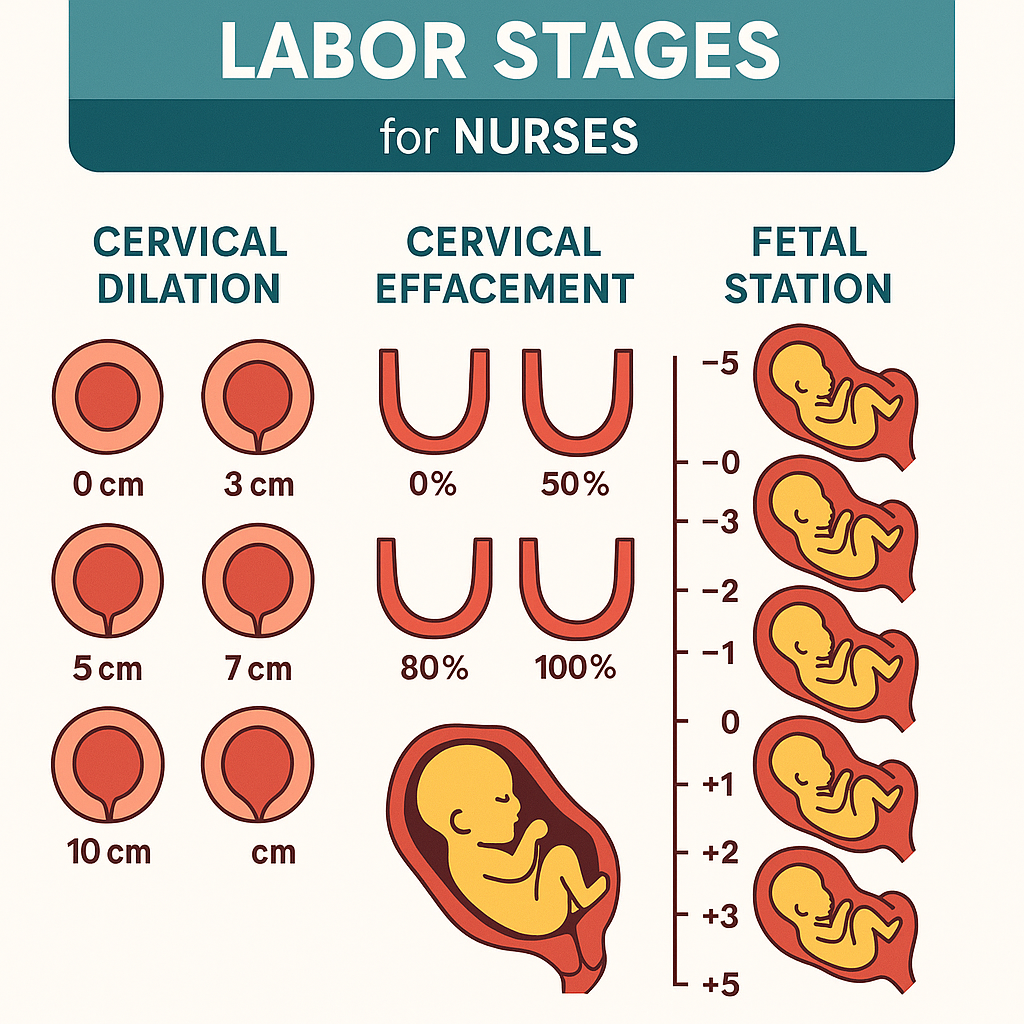Understanding the stages of labor is essential for every nurse, especially for those preparing for the NCLEX. From the first cervical changes to the final delivery of the placenta, knowing how to assess dilation, effacement, and fetal station helps the registered nurse (RN nurse) provide safe and effective care.
This guide breaks down the labor stages with visuals in mind so nursing students and practicing nurses can easily recall key points. Whether you’re studying through a nursing bundle or preparing for clinicals, these concepts will come up often.
🔹 Stage 1 of Labor – Cervical Dilation and Effacement
The first stage of labor is all about cervical changes.
- Cervical Dilation: The cervix opens from 0 cm to 10 cm.
- Early labor: 0–3 cm
- Active labor: 4–7 cm
- Transition: 8–10 cm
- Cervical Effacement: The cervix thins from 0% (thick) to 100% (fully thinned out).
📌 NCLEX tip: Nurses should assess dilation and effacement during vaginal exams to monitor progress. Slow dilation or failure to progress may indicate a need for interventions.
🔹 Stage 2 of Labor – Fetal Descent and Station
Once dilation reaches 10 cm, the second stage begins.
- Station describes how far the baby’s head has descended into the pelvis, measured in relation to the ischial spines.
- Negative numbers (-5 to 0): Baby is still high.
- Zero station (0): Baby’s head is at the level of the ischial spines.
- Positive numbers (+1 to +5): Baby is moving lower, closer to delivery.
📌 RN nurse priority: Encourage effective pushing, monitor fetal heart rate, and watch for complications like prolonged second stage or signs of fetal distress.
🔹 Stage 3 of Labor – Placenta Delivery
- Begins after the baby is born.
- Ends with the delivery of the placenta (usually within 5–30 minutes).
📌 NCLEX reminder: Retained placenta or excessive bleeding signals risk for postpartum hemorrhage. Nurses must monitor for firm uterine tone and bleeding.
🔹 Stage 4 of Labor – Immediate Recovery
- First 1–2 hours after placenta delivery.
- Nurse monitors:
- Fundal height and firmness
- Lochia (bleeding)
- Maternal vital signs
📌 NCLEX focus: This stage carries the highest risk for hemorrhage. Nurses should perform frequent assessments and act quickly if heavy bleeding occurs.
✅ Quick Nursing Bundle Recap
- Dilation = Opening of cervix (0–10 cm)
- Effacement = Thinning (0–100%)
- Station = Baby’s descent (-5 to +5)
- 4 Stages of Labor = Dilation → Pushing → Placenta → Recovery
For any nurse or nursing student, mastering these basics not only prepares you for the NCLEX but also builds confidence in real-world obstetric care.
Final Thoughts
Labor is dynamic, and each patient’s journey is unique. By visualizing cervical dilation, effacement, and fetal station, registered nurses can better communicate with patients, anticipate complications, and provide compassionate care.
Whether you’re a student studying with a nursing bundle or an RN nurse at the bedside, knowing these labor stages is non-negotiable.

